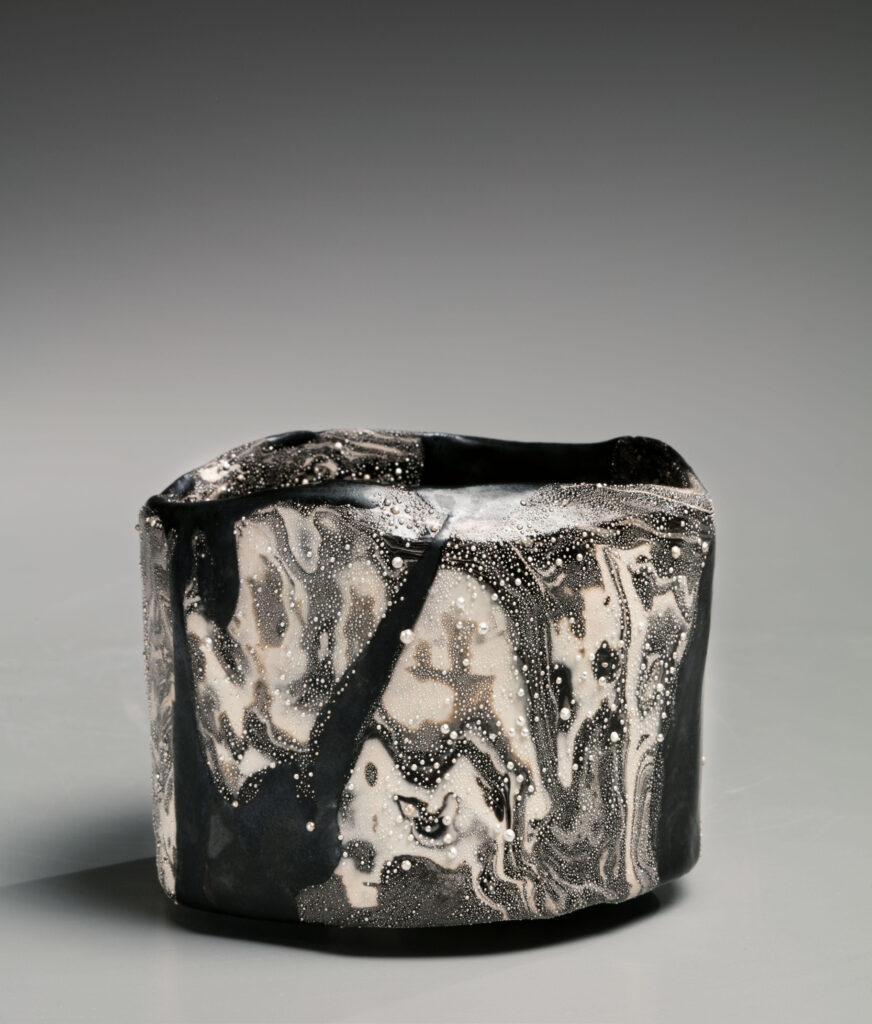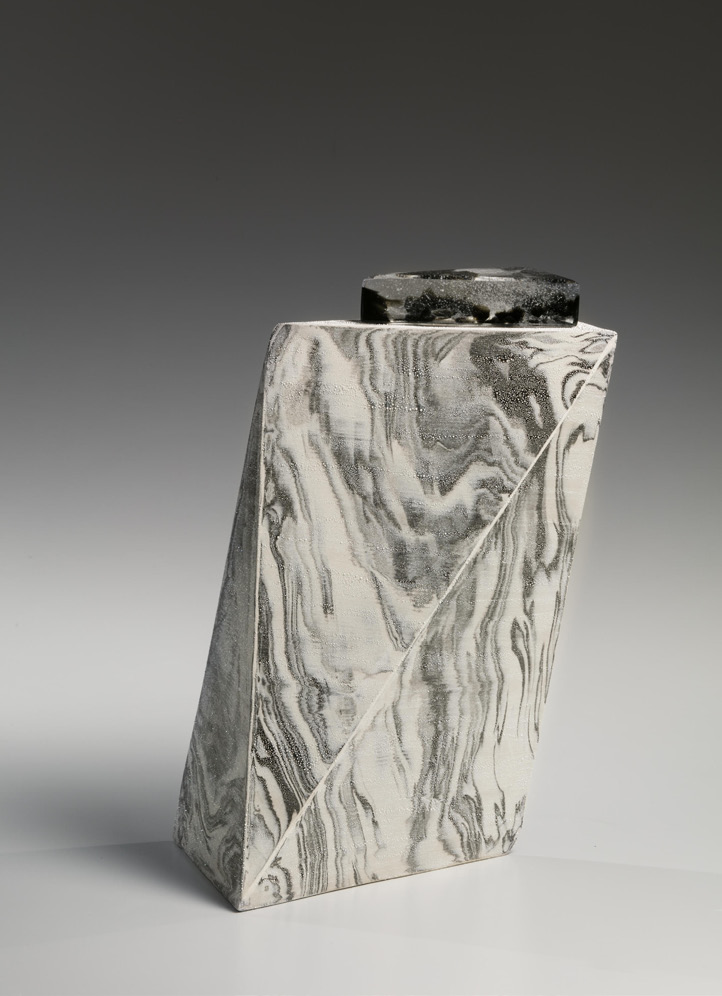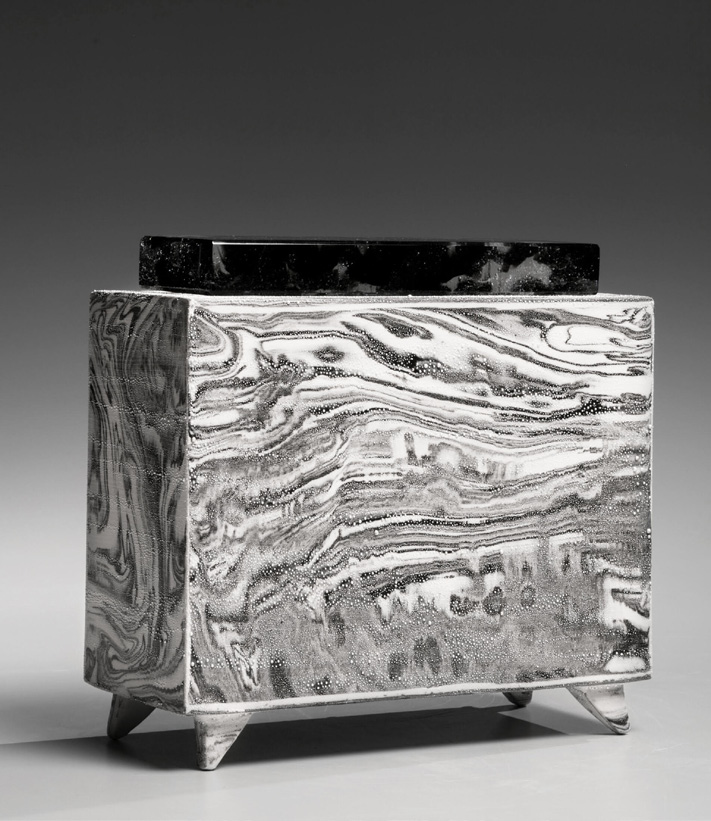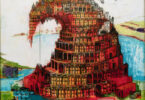
Marbleized porcelain, “silver mist” overglaze, 3¾ x 4¾ in.
Acclaimed artist Kondō Takahiro has broken with tradition and created a new artistic identity with the creation of his unique “silver mist” on view at a recent exhibition at Joan B. Mirviss Ltd. His distinctive silver mist is a radiant overglaze technique, an amalgam of platinum, gold, silver and glass frit (gold, silver and glass powders and pastes) to create the impression of dew drops on the surface of his ceramics. This glaze is so ephemeral that only the creator himself can capture it in words. “The process of creating these new sculptures made me more aware of how water, waves, and waterfalls flow,” says this esteemed artist.
“By incorporating a whiter clay, my work has evolved and been elevated. I feel that I have expressed the subtle and profound beauty of ink painting without using a brush, but by using clay.”
No surprise that his current solo exhibition at Joan B, Mirviss Ltd. is titled Making Waves. Water in all its forms —dew, fog, mist, ice, oceans— is central to this master artist’s work. Mirviss, the leading Western dealer in Japanese art, has worked with and exhibited Kondō for at least 20 years. “Water is his focus,” she says, describing his work as “swirling whirlpools of black, gray, and white marbleized porcelain that glisten with the silver mist.”
The two most important elements in ceramics are clay and fire. Kondō’s idea was to use clay as a medium to connect fire and water, “two very contrasting elements.” His range of forms, all endowed with the silver mist glaze in the Mirviss exhibition, includes five huge sculptures, one five-feet high; 15 table top sculptures; 12 tea bowls and seven glass-covered box-like forms.
The play of light on each sculpture’s surface is a key component of what Kondō calls
“porcelain-ink paintings.” All of his alluring geometric forms catch the light from different angles. The combination of darker and white clay appears to be in an ebb and flow motion. The work is alive, sensual, and imbued with endless possibilities. What Mirviss calls an “ink-on-paper” effect elevates his zig-zagging rhomboidal monoliths, glass-capped vessels and wondrous tea bowls to a level unseen even in contemporary Japanese ceramics.

Kondō Takahiro (b.1958) lives and works in Yamashina adjacent to the cultural capital of Kyoto in what was his grandfather’s original studio. Kondō Yuzō (1902-1985) was named a Living National Treasure in 1977 for his work in sometsuke, an underglaze in cobalt blue decoration. In spite of being born into a legendary family of ceramic artists famous for its blue-and-white porcelain, Kondō’s first passion was table tennis. He became Japan’s top ranked table-tennis player, before starting his ceramic career.
It was not until age 26 that Kondō returned to the world of clay. After working with his father, who was also a ceramic artist, Kondō continued his ceramic education in Kyoto. In 2003 he went to Scotland where he earned a Masters of Design and Applied Arts at Edinburgh College of Art in the study of glass.
While this formidable artist’s early career was traditional, he soon established his own identity, especially following the Great East Japan Earthquake and tsunami
of March 2011. He began to think of his work more philosophically, what role a ceramic artist could play in a world that produced such devastating tragedies. In response, Kondō produced a personal series of works that express his concerns about the deteriorating relationship between humanity and nature and how natural disasters reverberate throughout the world. At that time, he created a series of Zen-like meditative figures that are as memorable as anything you might see in any contemporary art gallery.

“Water has been his major theme for many years,” says Monika Bincsik, the Diane and Arthur Abbey Associate Curator of Japanese Decorative Arts at the Metropolitan Museum of Art which owns two Kondō works. He considers this element as a source of life and natural resource.”
Kondō has created powerful sculptures that you respond to intuitively as well as intellectually. His timeless luminous work honors the classic Japanese ceramic traditions and at the same time, revolutionizes them. G&S
Recently seen at mirviss.com





Leave a Comment